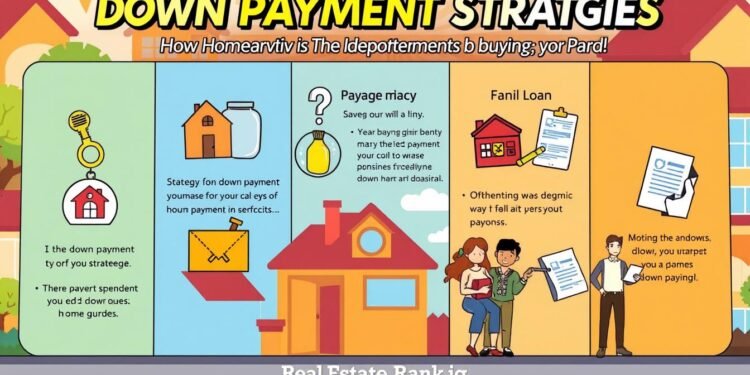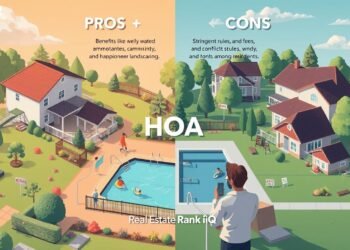The average down payment on a house in Florida is 10% to 20% of the price. That’s a lot of money, and you want to use it wisely. We’ve ranked the top 7 down payment strategies, from savings accounts to investments. Whether you’re buying your first home or upgrading, we’ve got you covered.
With the housing market and interest rates changing, it’s key to stay informed. Our top 7 down payment strategies and home buying tips will help you. We’ll explore conventional loans, FHA loans, and more. Plus, we’ll show you how to grow your down payment with high-yield savings and investments.
Are you ready to start your home buying journey? Our guide to the top 7 down payment strategies will help you. We’ll cover saving for a down payment and navigating mortgages and loans. Trust us to help you find your dream home with our expert advice.
Current Housing Market Overview and Down Payment Trends
The current housing market is changing fast, with down payment trends shifting quickly. The median down payment for U.S. homebuyers is now $67,500. This is a 14.8% jump from last year.
Home prices have also risen by 4% in the last 12 months. This increase is a big reason for the higher down payments.
The market conditions are impacting down payments in different ways. For example, the average mortgage rate in June was 6.92%. This is one of the highest rates in two decades.
This high rate has led to a rise in the average down payment requirements. The median down payment percentage is now 18.6%, the highest in over a decade.
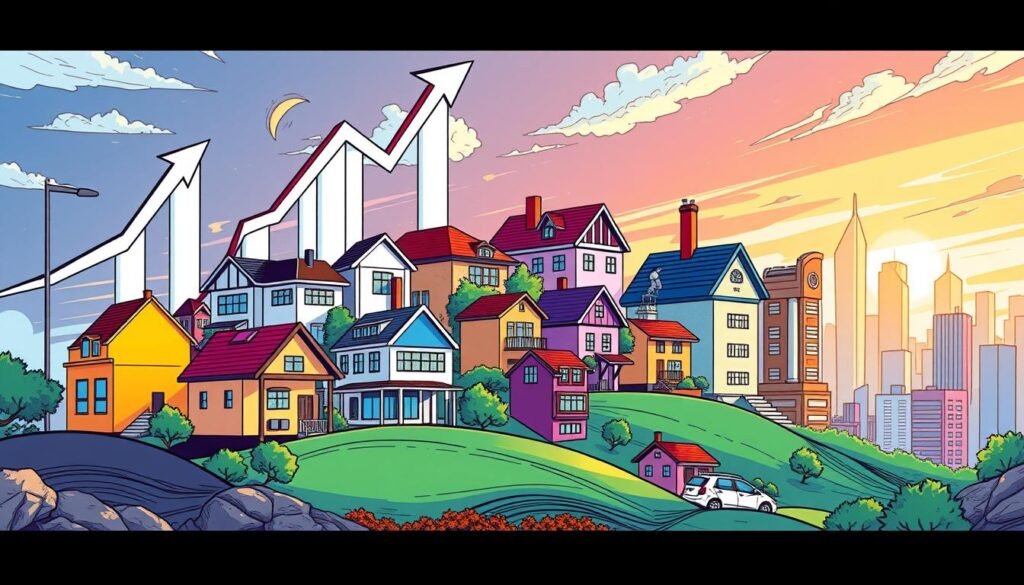
Some areas have higher average down payment requirements than others. San Francisco, San Jose, and Anaheim have the highest median down-payment percentages. They are at 25.8%, 25.7%, and 25%, respectively.
On the other hand, Virginia Beach, Detroit, and Jacksonville have the lowest median down-payment percentages. They are at 3%, 6.8%, and 8.6%, respectively.
It’s important for homebuyers to understand these down payment trends and market conditions. Knowing the average down payment requirements and how they vary by region helps. This knowledge aids in making better decisions about home purchases.
Understanding Traditional Down Payment Requirements
We’re all about making real estate info fun and easy to get. Let’s explore traditional down payment needs. Buying a home can feel overwhelming with all the down payment options. Usually, you need 5% to 20% of the home’s price. But, what does this really mean for you?
Down payment needs change based on your mortgage options. Some loans let you buy with just 3% down. Others might ask for 5% or 10%. It’s important to look at your choices and pick what’s best for you.
Here are some common down payment options:
- FHA loans: 3.5% – 10% down
- VA loans: 0% down
- Conventional fixed-rate loan: 3% – 5% down
- Adjustable-rate mortgages: 5% or more down
Think about the good and bad of each choice. For example, 20% down can save you money on insurance. But, less than 20% might mean paying for private mortgage insurance (PMI). This can raise your monthly payments.
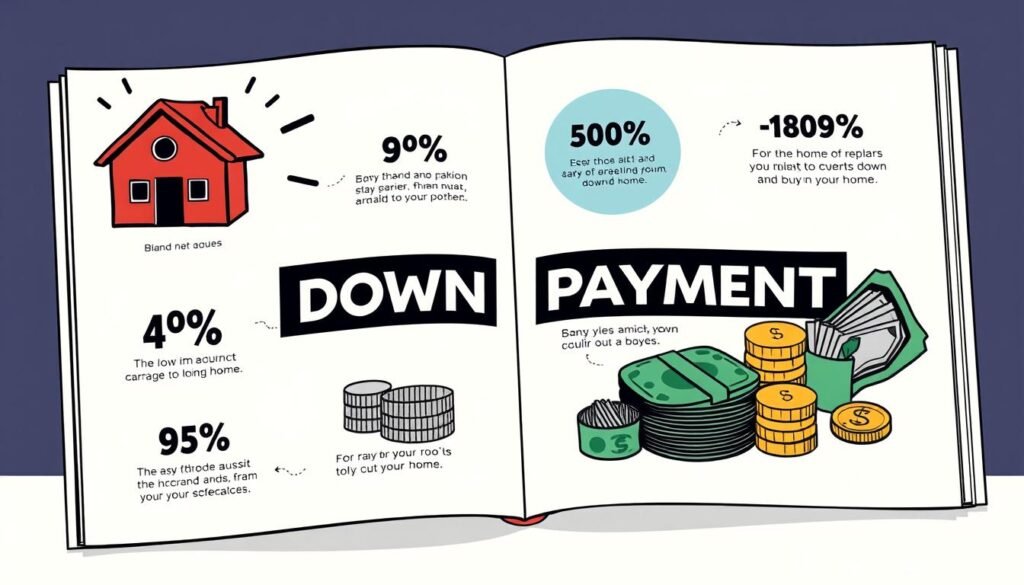
Knowing about traditional down payments is key to smart home buying. By looking at your mortgage options and weighing their pros and cons, you can find the right one. This way, you can reach your dream of owning a home.
| Mortgage Option | Down Payment Requirement |
|---|---|
| FHA Loan | 3.5% – 10% |
| VA Loan | 0% |
| Conventional Fixed-Rate Loan | 3% – 5% |
| Adjustable-Rate Mortgage | 5% or more |
Conventional Savings Strategy: High-Yield Accounts and Investment Options
Finding the best ways to save for a down payment is key. A conventional savings strategy is a good start. It uses high-yield accounts and investments to grow your money. High-yield savings accounts are great if you’re not sure when you’ll buy a house.
Let’s look at ways to boost your returns:
- High-yield savings accounts: These offer higher rates than regular bank accounts.
- Investment portfolios: They might give you higher returns than savings accounts, with the stock market averaging around 10% per year.
- Cash management accounts: These, from brokerage firms, offer flexibility and good interest rates.
When planning your savings, think about your personal goals and situation. Putting some of your income into a high-yield account or investment can help you reach your down payment goal. Always check and tweak your plan to stay on track.
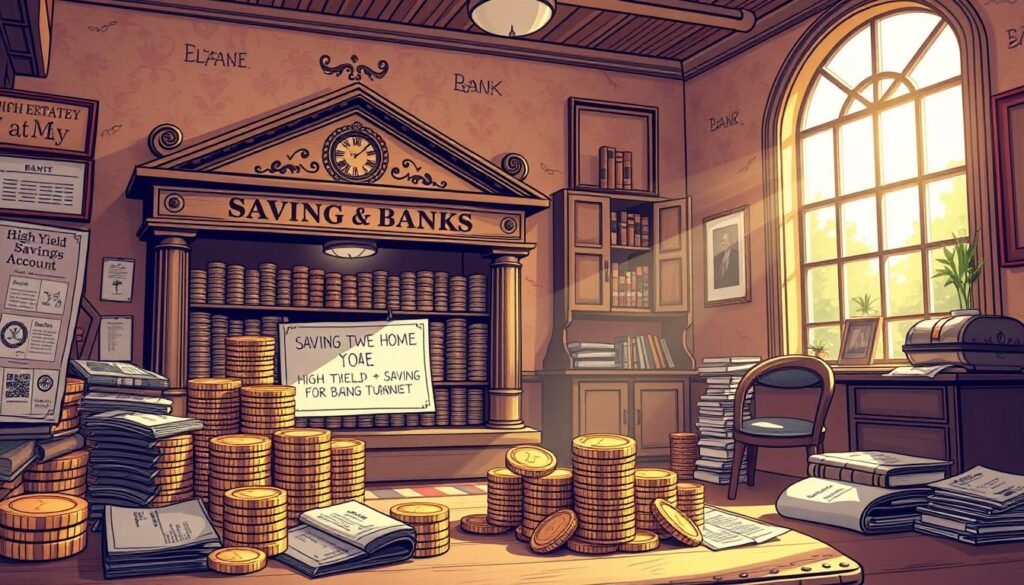
- Government bonds: These are safe investments backed by the U.S. government, with steady returns over time.
- Corporate bonds: Riskier, but they could offer higher yields for those who are willing to take on more risk.
- Money Market mutual funds: They pool high-quality, short-term debt from governments, banks, or corporations.
| Investment Option | Return Rate | Risk Level |
|---|---|---|
| High-Yield Savings Account | 2.90% – 4.75% | Low |
| Government Bonds | 1.5% – 3.5% | Low |
| Corporate Bonds | 4% – 6% | Medium |
Down Payment Assistance Programs and Government Options
We’re all about making homeownership more accessible. Down payment assistance programs help a lot. With over 2,000 programs in the U.S., there are many options. These programs offer grants or low-interest loans to help buyers own a home.
For example, the Alabama Housing Finance Authority’s (AHFA) program gives up to 4% of the purchase price. This is a maximum of $10,000 as a second mortgage. The Alaska Housing Finance Corporation (AHFC) also helps with down payments through grants, second mortgages, or forgivable loans for eligible buyers.
Here are some key benefits of down payment assistance programs:
- Grants or low-interest loans to help with down payment
- Government-backed loans with lower credit score requirements
- Mortgage assistance programs to help with monthly payments
Some conventional loans allow down payments as low as 3%. FHA loans require down payments as low as 3.5%. VA loans don’t require a down payment for eligible borrowers. With the right program, you can own a home.
| Program | Benefits | Eligibility |
|---|---|---|
| AHFA Down Payment Assistance | Up to 4% of purchase price, max $10,000 | First-time home buyers in Alabama |
| AHFC Down Payment Assistance | Grants, second mortgages, or forgivable loans | Eligible Alaskan home buyers |
Family Gifting and Co-Buying Arrangements
We’re all about making homeownership easier to get. Family gifting and co-buying are great ways to do this. Canadian parents have given their kids $10 billion for down payments in the last year. The average gift is $82,000, which is a big help in getting into the housing market.
So, how does it work? Family down payment gifts can help you buy a home. There are some rules to follow. For example, lenders need proof that the money was put into the buyer’s bank account. This must happen at least 15 business days before the mortgage closes.
Co-buying options like tenants-in-common ownership or joint tenancy are also available. These let you share the property ownership in different ways.
Here are some key things to consider when it comes to family gifting and co-buying arrangements:
- Gifts do not impact the borrower from a liability perspective as they are not considered loans
- There is no limit on the amount of money that can be gifted as a down payment
- Co-buying with parents can help young buyers afford a more desirable property and borrow less money
It’s important to think about the financial and legal sides before buying a property with parents. With the right approach, family gifting and co-buying can help you achieve your homeownership dreams. By understanding the rules for family down payment gifts and exploring co-buying options, you can make a choice that’s best for you and your family.
| Co-Buying Structure Options | Benefits |
|---|---|
| Tenants-in-Common Ownership | Ownership can be divided in various ways, such as 60:40 or 70:30 |
| Joint Tenancy | Ownership is split 50:50, and both parties have equal rights |
Leveraging Retirement Accounts for Down Payments
We’re all about finding creative ways to reach our real estate dreams. Using retirement accounts for down payments is a great idea. By tapping into your RRSP under the Home Buyers’ Plan, you can use your retirement savings to buy your dream home.
Here are some key points to keep in mind when using retirement accounts for down payments:
- Under the Home Buyers’ Plan, you can withdraw up to $35,000 from your RRSP for a down payment.
- This option is for first-time homebuyers. You must repay the amount within 15 years.
- Using your retirement savings for a down payment can be smart. But, think about your financial situation first.
When looking at down payment options, think about your long-term financial goals. Consider how using retirement accounts might affect your retirement savings. Research and weigh your options carefully to make the best choice for you.
Leveraging retirement accounts for down payments is a good option for those wanting their dream home. Just make sure to evaluate your finances well. Look at all down payment options before deciding.
| Retirement Account | Down Payment Option | Key Considerations |
|---|---|---|
| RRSP | Home Buyers’ Plan | Withdrawal limit, repayment terms, and tax implications |
| Other Retirement Accounts | Alternative Down Payment Options | Penalties, fees, and impact on retirement savings |
Creative Financing and Seller Concessions
We’re all about finding new ways to make buying a home easier. Creative financing is like a superpower for you. With seller concessions, you can get a better deal and own your dream home.
Want to know how to negotiate seller contributions? It’s about being smart and flexible. You can offer to pay some closing costs or repairs for a lower price. Or, you can look into bridge loan options to cover the mortgage gap.
Here are some perks of creative financing:
- Avoiding bank fees and credit checks
- Lower down payments
- Flexible financing options like lease-to-own or seller financing
By thinking outside the box, you can make buying a home cheaper and less stressful. So, don’t hesitate to negotiate those seller concessions. Your wallet will appreciate it!
| Financing Option | Benefits |
|---|---|
| Seller Financing | Avoid bank fees, lower down payments |
| Bridge Loan Options | Cover gap between old and new mortgage |
| Lease-to-Own | Flexible financing, lower down payments |
Impact of Credit Scores on Down Payment Requirements
We’re about to explore how credit scores affect down payments. Credit scores range from 300–850. They’re based on payment history, outstanding balances, and account types.
A good credit score can help you get a mortgage with better terms. For example, a score of 620 is needed for many conventional loans. Government-backed loans like FHA loans might accept a score as low as 580. So, what are the credit score thresholds and how do they impact down payments?
Credit Score Thresholds and Their Effects
Let’s look at the details:
- A score above 700 can get you better interest rates and more flexible down payments.
- Between 620-700, you might get moderate rates and standard down payments.
- Below 620, expect higher rates and stricter down payment rules.
Improving your credit score before applying for a mortgage can lead to better terms. Keeping credit card balances low and checking your credit regularly can help. This can improve your debt-to-credit ratio and increase your chances of getting a mortgage with a low down payment.
Lenders like a debt-to-income ratio (DTI) below 36%. Housing costs should not be more than 28% of your income. By understanding how credit scores affect down payments and improving your score, you can confidently apply for a mortgage. This can help you secure your dream home.
| Credit Score Range | Down Payment Requirements | Interest Rates |
|---|---|---|
| 700+ | Flexible | Low |
| 620-700 | Standard | Moderate |
| Below 620 | Stricter | High |
Private Mortgage Insurance vs. Larger Down Payments
When buying a home, we face a tough choice: private mortgage insurance or larger down payments? Let’s look at the good and bad of each choice. Mortgage insurance can cost a lot, from 2.80% to 4% of the mortgage. But, making larger down payments can help us skip private mortgage insurance.
Here are some important things to think about when choosing between private mortgage insurance and larger down payments:
- A 20% down payment can help us avoid private mortgage insurance
- Mortgage insurance costs $30 to $70 per month for every $100,000 borrowed
- Larger down payments can get us better interest rates and lower monthly payments
- Some mortgage programs offer down payment options as low as 3% or 3.5%
The choice between private mortgage insurance and larger down payments depends on our financial situation and goals. By understanding the pros and cons of each and looking at different down payment options, we can make a choice that fits us best.
Real Estate Market Timing and Down Payment Strategy Adjustments
We focus on making smart choices in the real estate market. Real estate market timing is key, and adjusting your down payment strategy is important. As the market changes, market trends help guide us. Whether you’re an experienced investor or a first-time buyer, knowing the down payment options is critical.
When tweaking your down payment plan, think about these:
- Interest rate changes
- How new policies affect the market
- How buyers and sellers act
These elements greatly shape the market. So, it’s vital to keep informed and adjust your strategy when needed.
In the complex real estate world, staying current on market trends is essential. Adjusting our down payment strategy helps us maximize our investment. This way, we can reach our goals in the shifting real estate scene.
Conclusion: Selecting the Right Down Payment Strategy for Your Situation
Choosing the right down payment strategy is key for a successful home purchase. We’ve seen many options, from saving money to creative financing. Online calculators give a basic idea, but you need to look at all the details that affect your mortgage options.
Whether you’re buying your first home or have done it before, it’s important to think about your finances, time frame, and goals. Look into unusual ways to save, like using retirement funds or negotiating with sellers. The right down payment strategy can lead to better rates, lower payments, and an easier path to owning a home.
There’s no single answer for everyone – the best choice depends on your situation. Stay up to date, take action, and work with your real estate and mortgage teams. With the right strategy, you’ll be closer to making your dream of homeownership come true.
FAQ
What are the top 7 down payment strategies for buying a home?
The article talks about the best ways to save for a down payment. It covers high-yield savings accounts and investment options. It also looks at down payment assistance programs and family gifting.
It discusses leveraging retirement accounts and creative financing. Lastly, it talks about adjusting your strategy based on the real estate market timing.
How are current housing market conditions affecting down payment trends?
The article explains how market conditions impact down payment strategies. It talks about average down payment requirements by region. It also discusses the effect of interest rates on down payments.
What are the traditional down payment requirements for home purchases?
Typically, down payments range from 5% to 20% of the purchase price. The article explores different down payment options and mortgage choices. It highlights the benefits of putting down 20% or more to avoid default insurance.
How can high-yield savings accounts and investment options be used to grow down payment funds?
The article offers tips on maximizing returns with high-yield savings accounts. It explores investment vehicles for down payment savings. It also suggests using timeline-based saving strategies to reach your goal.
What down payment assistance programs and government options are available to home buyers?
The article looks at down payment assistance programs and government-backed loans. It explains how these options can make homeownership more accessible for buyers.
How can family gifting and co-buying arrangements be used for down payments?
The article discusses guidelines for family down payment gifts. It explores co-buying structure options. It also examines legal considerations for shared ownership arrangements.
How can retirement accounts be leveraged for down payments?
The article explores using retirement savings vehicles, like RRSPs, for down payments. It focuses on options for first-time homebuyers.
What creative financing and seller concession strategies can be used to secure a better home purchase deal?
The article discusses negotiating seller contributions. It explores bridge loan options and piggyback loan strategies. These can help get a better deal on a home purchase.
How does a buyer’s credit score impact their down payment requirements?
The article explains how credit score thresholds affect down payment terms. It provides tips on improving credit for better down payment options.
What are the pros and cons of private mortgage insurance (PMI) compared to larger down payments?
The article examines the cost implications of PMI versus larger down payments. It explores mortgage insurance options available to buyers.
How can real estate market timing affect down payment strategies?
The article discusses adjusting down payment strategies based on market trends. It talks about mortgage rates and housing prices to ensure the best decision for your home purchase.


